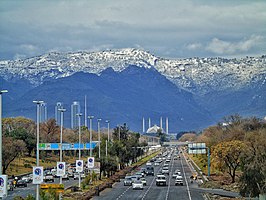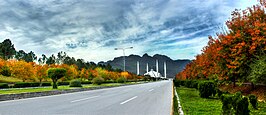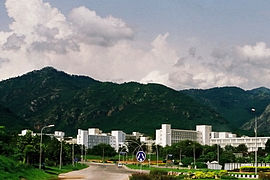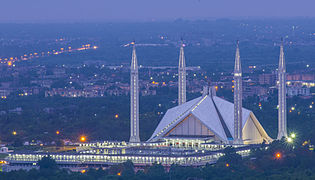The Islamabad Capital Territory (ICT; Urdu: وفاقی دارالحکومت, romanized: Vafāqī Dār-alhakūmat) is the only federal territory of Pakistan and contains Islamabad, the capital of Pakistan. Located on the northern edge of the Pothohar Plateau and at the foot of the Margalla Hills, The ICT shares borders with the province of Khyber Pakhtunkhwa in the west and with the province of Punjab in the remaining directions. It covers an area of 906.5 square kilometres (350 sq mi) and according to the 2023 national census, has a population of over 1 million in the city proper, while over 2 million in the whole territory.[5] The territory is represented in the National Assembly by NA-52, NA-53, and NA-54 constituencies and by four seats in the Senate.
History
In 1960, land was transferred from Rawalpindi District of Punjab province to replace Karachi Federal Capital Territory and establish Pakistan's new capital. According to the 1960s master plan, the Capital Territory included Rawalpindi, and was to be composed of the following parts:[8]
- Rawalpindi, 259 square kilometres (100 sq mi)
- Islamabad Urban, 220.15 square kilometres (85.00 sq mi)
- Margalla Hills, 220.15 square kilometres (85.00 sq mi)
- Islamabad Rural, 466.20 square kilometres (180.00 sq mi)[4]
However, Rawalpindi was eventually excluded from the Islamabad master plan in the 1980s.[8]
Administration

Zones

Islamabad is subdivided into five zones:[9][10]
- Zone I: Designated for urban development and federal government institutions
- Zone II: Designated for urban development
- Zone III: Designated for rural development
- Zone IV: Designated for rural development
- Zone V: Designated for rural development
Sectors
Union councils
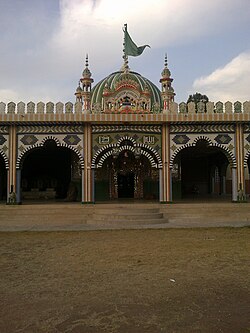
Islamabad Capital Territory comprises urban and rural areas. The rural consists of 23 union councils, comprising 133 villages, while urban has 27 union councils.[11]
| UC # | Chief locality | Localities within jurisdiction |
|---|---|---|
| 1 | Saidpur | Said Pur, Gokina, Talhar |
| 2 | Noorpur Shahan | Noorpur Shahan, Ratta Hutar |
| 3 | Mal Pur | Mal Pur, Romali, Nariyas, Phadu, Shahdrah Khurd, Shahdrah Kalan, Mandala, Jang Begial, Subban Syedan, Mangial, Quaid-e-Azam University |
| 4 | Kot Hathial (Shamal) | Kot Hathial, Bhara Kahu, Nayiabadi, Muhallah Alnoor, Muhallah Ban, Muhallah Malkan, Dhok Syedan |
| 5 | Kot Hathial (Janoob) | Kot Hathial, Nainsukh, Barakahu, Behra Syedan, Muhallah Ghousia, Sharak-e-Madina, Dhok Jilani, Muhallah Malikabad |
| 6 | Phulgran | Phulgran, Phul Garan, Dhok Kuch, Abbasiabad, Dhok Badhan, Muhallah Kangar, Mahallah Ranjpuran, Shahpur, Bobry, Karlot Chattar, Mohra Rajpoota, Muhallah Sumbul, Bani Gala |
| 7 | Pind Begwal | Pind Begwal, Bainala, Maira Biguwal, Atthal, Dhok Sajjal, Dhok Nanda Sihali, Jandala, Simli |
| 8 | Tumair | Tumair, Pihont, Chakhtan, Darkalam, Kanjnah |
| 9 | Charah | Charah, Dhok Maira, Dhok Las, Kiani, Dhok Haveli |
| 10 | Kirpa | Kirpa, Ladhiot Syedan, Pind Malikan, Dhok Ban, Bhimbar Tarar, Mahallah Haveli Rajgan, Mehfozabad, Chaniol, Muhallah Chaudrian, Ara, Gora Mast, Dhok Jogian Harnu, Chauntra Sogran |
| 11 | Mughal | Mughal, Hardoghar, Kangota Gujjran Sihala, Hondamial, Nara Syedan, Chuchkal Chakiyan, Chak Kamdar |
| 12 | Rawat | Rawat, Bhangrial Kalan, Banni Saran, Mohra Nagial, Sawan, Bagga Shaikhan |
| 13 | Humak | Humak, Kaniyal, Gora Syedan, Niazian |
| 14 | Sihala | Sihala Khurd, Maira Dakhli, Bhandar Sihala, Jarki Sihala, Gagri Sihala, Jhundla, Kangota Syedan, Gura Mistriyan |
| 15 | Lohi Bhair | Lohi Bhar, Shahrak-e-Korang, Bagh-e-Sawan, Shahrak-e-Pakistan |
| 16 | Darwala | Darwala, Dhaliala, Panwal, Chucha Sheikhiyan, Bhair, Kanghar, Sher Ghamial, Dhok Kavgar, Kathrial, Chucha, Dhok Kashimiriya, Harn maira, Malali, Bun koutha, Pahg Panwal, Farash, Bangiyal |
| 17 | Koral | Koral, Tarlai Khurd, Gangal, Chaklala, Shareefabad, Gohra Sardar, Tarlai |
| 18 | Khana Dak | Khana Dak, Dhok Jabba, Pindorian, Shahrak-e-Bilal, Shahrak-e-Barma, Shahrak-e-Madina, Muhallah Wahid Abad, Shahrak-e-Masih) |
| 19 | Tarlai Kalan | Tarlai Kalan, Irfanabad, Chappar Meer Khanal, Sahana |
| 20 | Ali Pur | Ali Pur, Alipur,Jhang Syedan,Partal, Khadrapar, Farash, |
| 21 | Sohan | Sohan Dehati, Khana Kak, Shakrial, Shakrial (Sharki) |
| 22 | Chak Shahzad | Chak Shahzad, Chak Bihra Shigh, Jaba Teli, Sohana, Pandori, Chhatta Bakhtawar, Bohan, Dhoke Sharaf, Mujuhan |
| 23 | Kuri | Kuri, Malot, Rakh Bani Gala, Rihara, Mohra Jujan |
| 24 | Shahrak-e-Rawal | Shahrak-e-Rawal, Shahrak-e-Margala, Sumbal Korakh, Puna Faqeeran, Mohrian |
| 25 | Sector F-6 | F-6/1, F-6/2, F-6/3, F-6/4, Farooqi Bazar, Madni Masjid, Dhobi Gat |
| 26 | Sector G-6/1 | |
| 27 | Sector G-6 | Sector G-6/2, Sector G-6/3 & Sector G-6/4 |
| 28 | Sector F-7, F-8, F-9 | |
| 29 | Sector F-10, F-11 | |
| 30 | Sector G-7/3, G-7/4 | |
| 31 | Sector G-7/1, G-7/2 | |
| 32 | Sector G-8/3, G-8/4 | |
| 33 | Sector G-8/1, G-8/2 | |
| 34 | Sector G-9 | Sector G-9/1, G-9/3, G-9/4 |
| 35 | Sector G-9/2 | |
| 36 | Sector G-10/3, G-10/4 | |
| 37 | Sector G-10/1, G-10/2 | |
| 38 | Sector G-11 | Sector G-11/1, G-11/2, G-11/3, G-11/4 |
| 39 | Maira Sumbal Jaffar | Maira Sumbal Jaffar, Golra Sharif, Badia Rusmat Khan, Maira Akku, Dhareek Mohri, Shahrak-e-Effaq |
| 40 | G-13 | |
| 40 | Sector I-8 | Sector I-8/1,I8/2,I8/3,I8/4 |
| 41 | Sector I-9 | |
| 42 | Sector I-10/1 | |
| 43 | Sector I-10 | Sector I-10/2, I-10/3, I-10/4 |
| 44 | Bokra | Bokra, Haji Complex, Soria Harboza, Mouza Sorain, Peer Wadhai, Shahrak-e-Iqbal |
| 45 | Jhangi Saydan | |
| 46 | Village Noon | Badhana Kalan, Dhoke Makhan, ETC |
| 47 | Tarnol | |
| 48 | Sarai Kharbooza | |
| 49 | Shah Allah Ditta | |
| 50 | Golra Sharif |
Climate

Seasons
The climate of Islamabad has a humid subtropical climate (Köppen: Cwa), with five seasons: winter (November–February), spring (March and April), summer (May and June), rainy monsoon (July and August), and autumn (September and October).
Temperatures
The temperatures range from 13 °C (55 °F) in January to 38 °C (100 °F) in June. The hottest month is June, where average highs routinely exceed 38 °C (100.4 °F), while the coolest month is January. The highest recorded temperature was 46.6 °C (115.9 °F) on 23 June 2005 while the lowest temperature was −6 °C (21.2 °F) on 17 January 1967.[12][13] Winters generally feature dense fog in the mornings and sunny afternoons. In the city, temperatures stay mild, with snowfall over the higher elevations points on nearby hill stations, notably Murree and Nathia Gali.
Precipitation
The wettest month is July, with heavy rainfalls and evening thunderstorms with the possibility of cloudburst and flooding. Highest monthly rainfall of 743.3 millimetres (29.26 in) was recorded during July 1995.[14] On 23 July 2001, Islamabad received a record breaking 620 millimetres (24 in) of rainfall in just 10 hours. It was the heaviest rainfall in Islamabad in the past 100 years and the highest rainfall in 24 hours as well.[15][16] The city has also experienced snowfall on a number of occasions.Islamabad's micro-climate is regulated by three artificial reservoirs: Rawal, Simli, and Khanpur Dam. The latter is located on the Haro River near the town of Khanpur, about 40 kilometres (25 mi) from Islamabad. Simli Dam is 30 kilometres (19 mi) north of Islamabad.
Vegetation
Around 220 acres (89 ha) of the city consists of the Margalla Hills National Park, while the Loi Bher Forest is situated along the Islamabad Highway, covering an area of 1,087 acres (440 ha).[17]
| Climate data for Islamabad (1991-2020) | |||||||||||||
|---|---|---|---|---|---|---|---|---|---|---|---|---|---|
| Month | Jan | Feb | Mar | Apr | May | Jun | Jul | Aug | Sep | Oct | Nov | Dec | Year |
| Record high °C (°F) | 30.1 (86.2) | 30.0 (86.0) | 37.0 (98.6) | 44.0 (111.2) | 45.6 (114.1) | 50.0 (122.0) | 45.0 (113.0) | 42.0 (107.6) | 38.1 (100.6) | 38.0 (100.4) | 32.2 (90.0) | 28.3 (82.9) | 50.0 (122.0) |
| Mean daily maximum °C (°F) | 17.7 (63.9) | 20.0 (68.0) | 24.8 (76.6) | 30.6 (87.1) | 36.1 (97.0) | 38.3 (100.9) | 35.4 (95.7) | 33.9 (93.0) | 33.4 (92.1) | 30.9 (87.6) | 25.4 (77.7) | 20.4 (68.7) | 28.9 (84.0) |
| Daily mean °C (°F) | 10.7 (51.3) | 13.4 (56.1) | 18.1 (64.6) | 23.6 (74.5) | 28.7 (83.7) | 31.4 (88.5) | 30.1 (86.2) | 29.1 (84.4) | 27.6 (81.7) | 23.3 (73.9) | 17.3 (63.1) | 12.5 (54.5) | 22.2 (71.9) |
| Mean daily minimum °C (°F) | 3.6 (38.5) | 6.8 (44.2) | 11.4 (52.5) | 16.6 (61.9) | 21.5 (70.7) | 24.5 (76.1) | 24.9 (76.8) | 24.2 (75.6) | 21.7 (71.1) | 15.6 (60.1) | 9.1 (48.4) | 4.7 (40.5) | 15.4 (59.7) |
| Record low °C (°F) | −6 (21) | −5.0 (23.0) | −3.8 (25.2) | 2.1 (35.8) | 5.5 (41.9) | 13 (55) | 15.2 (59.4) | 14.5 (58.1) | 13.3 (55.9) | 5.7 (42.3) | −0.6 (30.9) | −2.8 (27.0) | −6.0 (21.2) |
| Average precipitation mm (inches) | 55.2 (2.17) | 99.5 (3.92) | 96.5 (3.80) | 58.1 (2.29) | 39.9 (1.57) | 78.4 (3.09) | 310.6 (12.23) | 317.0 (12.48) | 135.4 (5.33) | 34.4 (1.35) | 17.7 (0.70) | 25.9 (1.02) | 1,268.6 (49.95) |
| Average precipitation days (≥ 1.0 mm) | 4.7 | 8.0 | 7.3 | 6.1 | 5.2 | 6.0 | 12.3 | 11.9 | 6.4 | 2.9 | 2.0 | 2.0 | 74.8 |
| Mean monthly sunshine hours | 195.7 | 187.1 | 202.3 | 252.4 | 319.0 | 300.1 | 264.4 | 250.7 | 262.2 | 275.5 | 247.9 | 195.6 | 2,952.9 |
| Source 1: NOAA (sun, 1961-1990)[18][19] | |||||||||||||
| Source 2: PMD (extremes)[20] | |||||||||||||
Cityscape
Civic administration
The main administrative authority of the city is Islamabad Capital Territory Administration with some help from Metropolitan Corporation Islamabad and Capital Development Authority (CDA), which oversees the planning, development, construction, and administration of the city. Islamabad Capital Territory is divided into eight zones: Administrative Zone, Commercial District, Educational Sector, Industrial Sector, Diplomatic Enclave, Residential Areas, Rural Areas and Green Area.
Islamabad city is divided into five major zones: Zone I, Zone II, Zone III, Zone IV, and Zone V. Out of these, Zone IV is the largest in area. All sectors of Ghouri Town (1, 2, 3, VIP, 5, 4-A, 4-B, 4-C, 5-A, 5-B and sector 7) are located in this zone. Zone I consists mainly of all the developed residential sectors, while Zone II consists of the under-developed residential sectors. Each residential sector is identified by a letter of the alphabet and a number, and covers an area of approximately 4 square kilometres. The sectors are lettered from A to I, and each sector is divided into four numbered sub-sectors.[21]
Sectors
Series A, B, and C are still underdeveloped. The D series has seven sectors (D-11 to D-17), of which only sector D-12 is completely developed. This series is located at the foot of Margalla Hills.[22] The E Sectors are named from E-7 to E-17. Many foreigners and diplomatic personnel are housed in these sectors.[22] In the revised Master Plan of the city, CDA has decided to develop a park on the pattern of Fatima Jinnah Park in sector E-14. Sectors E-8 and E-9 contain the campuses of Bahria University, Air University, and the National Defence University.[23][24][25] The F and G series contains the most developed sectors. F series contains sectors F-5 to F-17; some sectors are still under-developed. F-5 is an important sector for the software industry in Islamabad, as the two software technology parks are located here. The entire F-9 sector is covered with Fatima Jinnah Park. The Centaurus complex will be one of the major landmarks of the F-8 sector.[22] G sectors are numbered G-5 through G-17. Some important places include the Jinnah Convention Center and Serena Hotel in G-5, the Red Mosque in G-6, and the Pakistan Institute of Medical Sciences, the largest medical complex in the capital, located in G-8.[22]
The H sectors are numbered H-8 through H-17. The H sectors are mostly dedicated to educational and health institutions. National University of Sciences and Technology covers a major portion of sector H-12.[22] The I sectors are numbered from I-8 to I-18. With the exception of I-8, which is a well-developed residential area, these sectors are primarily part of the industrial zone. Currently two sub-sectors of I-9 and one sub-sector of I-10 are used as industrial areas. CDA is planning to set up Islamabad Railway Station in Sector I-18 and Industrial City in sector I-17.[22] Zone III consists primarily of the Margalla Hills and Margalla Hills National Park. Rawal Lake is in this zone. Zone IV and V consist of Islamabad Park, and rural areas of the city. The Soan River flows into the city through Zone V.
Demographics
Language
While urban Islamabad is home to people from all over Pakistan as well as expatriates, in the rural areas a number of Pothohari speaking tribal communities can still be recognised.[27]
Religion
Islam is the largest and most practiced religion in the territory, with over 95% of the population adhereing to the faith. Christianity is the second largest religion and forms 4.1% of the population. Other minorites, like Hindus, form just 0.02% of the population, while Ahmedis make up 0.34%. Other minorities, like Sikhs and Jews, form just 0.03% combined.[28]
Islamabad-Rawalpindi metropolitan area
When the master plan for Islamabad was drawn up in 1960, Islamabad and Rawalpindi, along with the adjoining areas, was to be integrated to form a large metropolitan area called Islamabad/Rawalpindi Metropolitan Area. The area would consist of the developing Islamabad, the old colonial cantonment city of Rawalpindi, and Margalla Hills National Park, including surrounding rural areas.[30][31] However, Islamabad city is part of the Islamabad Capital Territory, while Rawalpindi is part of Rawalpindi District, which is part of province of Punjab.[32]
Initially, it was proposed that the three areas would be connected by four major highways: Murree Highway, Islamabad Highway, Soan Highway, and Capital Highway. However, to date, only two highways have been constructed: Srinagar Highway (formerly known as Murree Highway and later as Kashmir Highway) and Islamabad Highway.[31] Plans of constructing Margalla Avenue are also underway.[33] Islamabad is the hub all the governmental activities while Rawalpindi is the centre of all industrial, commercial, and military activities. The two cities are considered sister cities and are highly interdependent.[30]
- Chaghi Monument
- Pakistan Secretariat
- Star and Crescent Monument near the start of Shakarparian
- Daman-e-Koh Park
- Sunset over the Lake View Park
- view of Blue Area, the commercial hub of the city.
Economy
Islamabad is a net contributor to the Pakistani economy, as whilst having only 0.8% of the country's population, it contributes 1% to the country's GDP.[34] Islamabad Stock Exchange, founded in 1989, is Pakistan's third largest stock exchange after Karachi Stock Exchange and Lahore Stock Exchange.[35] The exchange has 118 members with 104 corporate bodies and 18 individual members. The average daily turnover of the stock exchange is over 1 million shares.[36] As of 2012, Islamabad LTU (Large Tax Unit) was responsible for Rs 371 billion in tax revenue, which amounts to 20% of all the revenue collected by Federal Board of Revenue.[37]
Islamabad has seen an expansion in information and communications technology with the addition two Software Technology Parks, which house numerous national and foreign technological and information technology companies. The tech parks are located in Evacuee Trust Complex and Awami Markaz. Awami Markaz houses 36 IT companies while Evacuee Trust house 29 companies.[38] Call centres for foreign companies have been targeted as another significant area of growth, with the government making efforts to reduce taxes by as much as 10% to encourage foreign investments in the information technology sector. Most of Pakistan's state-owned companies like PIA, PTV, PTCL, OGDCL, and Zarai Taraqiati Bank Ltd. are based in Islamabad. Headquarters of all major telecommunication operators such as PTCL, Mobilink, Telenor, Ufone, and China Mobile are located in Islamabad. Being an expensive city, the prices of most of fruits, vegetable and poultry items increased in Islamabad during the year 2015-2020[39]
Tourism
Transport
Airport
Islamabad is connected to major destinations around the world through the Islamabad International Airport. The airport is the largest in Pakistan, handling 9 million passengers per annum. The airport was built at a cost of $400 million and opened on 3 May 2018, replacing the former Benazir Bhutto International Airport. It is the first greenfield airport in Pakistan with an area of 3,600-acre (15 km2).[40]
Metrobus
The Rawalpindi-Islamabad Metrobus is a 24 km (14.9 mi) bus rapid transit system that serves the twin cities of Rawalpindi and Islamabad in Pakistan. It uses dedicated bus lanes for all of its route covering 24 bus stations. Islamabad is well connected with other parts of the country through car rental services such as Alvi Transport Network and Pakistan Car Rentals.[citation needed]
Motorways
All major cities and towns are accessible through regular trains and bus services running mostly from the neighbouring city of Rawalpindi. Lahore and Peshawar are linked to Islamabad through a network of motorways, which has significantly reduced travelling times between these cities. M-2 Motorway is 367 km (228 mi) long and connect Islamabad and Lahore.[41] M-1 Motorway connects Islamabad with Peshawar and is 155 km (96 mi) long.[41] Islamabad is linked to Rawalpindi through the Faizabad Interchange, which has a daily traffic volume of about 48,000 vehicles.[42]
Education
Islamabad has the highest literacy rate of Pakistan at 95%.[43] Islamabad also has some of Pakistan's major universities, including Quaid-i-Azam University, the International Islamic University, and the National University of Sciences and Technology and Pakistan Institute of Engineering and Applied Sciences
Private School Network Islamabad is working for private educational institutions. The president of PSN is Dr. Muhammad Afzal Babur from Bhara Kahu. PSN is divided into eight zones in Islamabad. In Tarlai Zone Chaudhary Faisal Ali from Faisal Academy Tarlai Kalan is Zonal General Sectary of PSN.
Quaid-e-Azam University has several faculties. The institute is located in a semi-hilly area, east of the Secretariat buildings and near the base of Margalla Hills. This Post-Graduate institute is spread over 1,705 acres (6.90 km2). The nucleus of the campus has been designed as an axial spine with a library as its center.Other universities include the following:[44]
- Bahria University
- Air University
- Quaid-e-Azam University
- Allama Iqbal Open University (AIOU)
- Alkauthar Islamic University
- COMSATS Institute of Information Technology (CIIT)
- Capital University of Science and Technology (CUST) [Formally Mohammad Ali Jinnah University, Islamabad Campus]
- Federal Urdu University of Arts, Science & Technology (FUUAST)
- National University of Sciences and Technology (NUST)
- National Defense University, Islamabad(NDU)
- National University of Modern Languages (NUML)
- Institute of Space Technology
- International Islamic University Islamabad
- Institute of Cost and Management Accountants of Pakistan (ICMAP)
- Institute of Chartered Accountants of Pakistan (ICAP)
- Pakistan Institute of Development Economics (PIDE)
- Pakistan Institute of Engineering and Applied Sciences (PIEAS)
- Shifa College of Medicine
- Foundation University Islamabad (FUI)
- National University of Computer & Emerging Sciences(FAST-NUCES)
- Riphah International University
- University of Lahore
- Center for Advanced Studies in Engineering
- Preston University Islamabad Campus
- Iqra University Islamabad Campus
- Shaheed Zulfiqar Ali Bhutto Institute of Science and Technology (ZABIST)
- Hamdard University Islamabad Campus
Sports
Islamabad United became the first ever team to win Pakistan Super League in 2016.[45] And now the federal team Is participating in the Pakistan Cup.
See also
References
External links
![]() Islamabad travel guide from Wikivoyage
Islamabad travel guide from Wikivoyage
